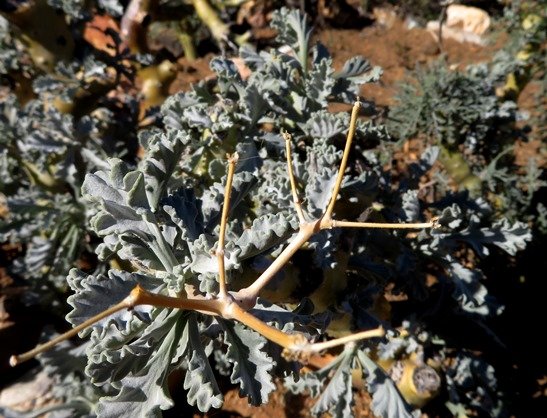Pelargonium klinghardtense dry panicle remains

Author: Ivan Lätti
Photographer: Thabo Maphisa
The dry, fork branched stalk of a Pelargonium klinghardtense inflorescence typically remains above the stem-tip foliage as in the photo. It will usually still be there at the end of summer when the leaves are long gone. This plant is old and large, glimpses of chunky, olive-green, blue-green to dull yellow stem parts visible among the new season’s grey-velvety foliage. These buff-coloured flower stalk remains suggest that quite a few pseudo-umbel inflorescences have been produced by the strong plant. The more the resources, the bigger the crop! Plants don’t shirk!
Preceding this the plant grew an inflorescence from a stem-tip or near it, comprising several pseudo-umbels on peduncles of 1,5 cm to 7,5 cm, each with two to six (occasionally more) flowers. Small leaves are present at the peduncle (flower stalk) base. The dull creamy green sepals are pointed and recurve a little.
Small, white, five-petalled flowers grow on pedicels of 1 cm to 2,5 cm. The posterior (upper) pair of petals are very slightly larger than the anterior (lower) three and none of the petals are marked in any way. The posterior petals bend back slightly more than the anterior ones. There are five fertile stamens per flower on filaments of three lengths. The five-branched stigma is purple as are the chunky anthers that are also sometimes beige. The pollen is orange. Flowering happens during winter and early spring.
The leaves show sinewy stalks supporting smooth and busily undulating blades. There is variation in the shape and size of leaf margin toothing, as well as in the undulations of the blade halves that are partly upturned from the midrib (Frandsen, 2017; Smith, et al, 2017; Le Roux, et al, 2005; iNaturalist; www.bihrmann.com; https://www.llifle.com; www.pelargonium.si).

